Report: Business Model Canvas of Travelport Locomote, MGMT20143
VerifiedAdded on 2023/01/13
|13
|2656
|79
Report
AI Summary
This report provides a comprehensive analysis of Travelport Locomote's business model, focusing on its application of the Business Model Canvas framework. The analysis begins with an executive summary outlining the report's scope, which includes an examination of the company's operations within the Australian travel service industry, specifically its focus on customized travel services for corporate clients. The report then delves into the nine building blocks of the Business Model Canvas, detailing customer segments, key partners, value propositions, key activities, channels, revenue streams, cost structure, key resources, and customer relationships. It explores the interrelationships among these building blocks, critical success factors, and potential downside risks faced by the company. The report concludes with recommendations for business model changes, such as enhancing promotional activities and improving customer information access, to strengthen Travelport Locomote's market position and operational effectiveness.
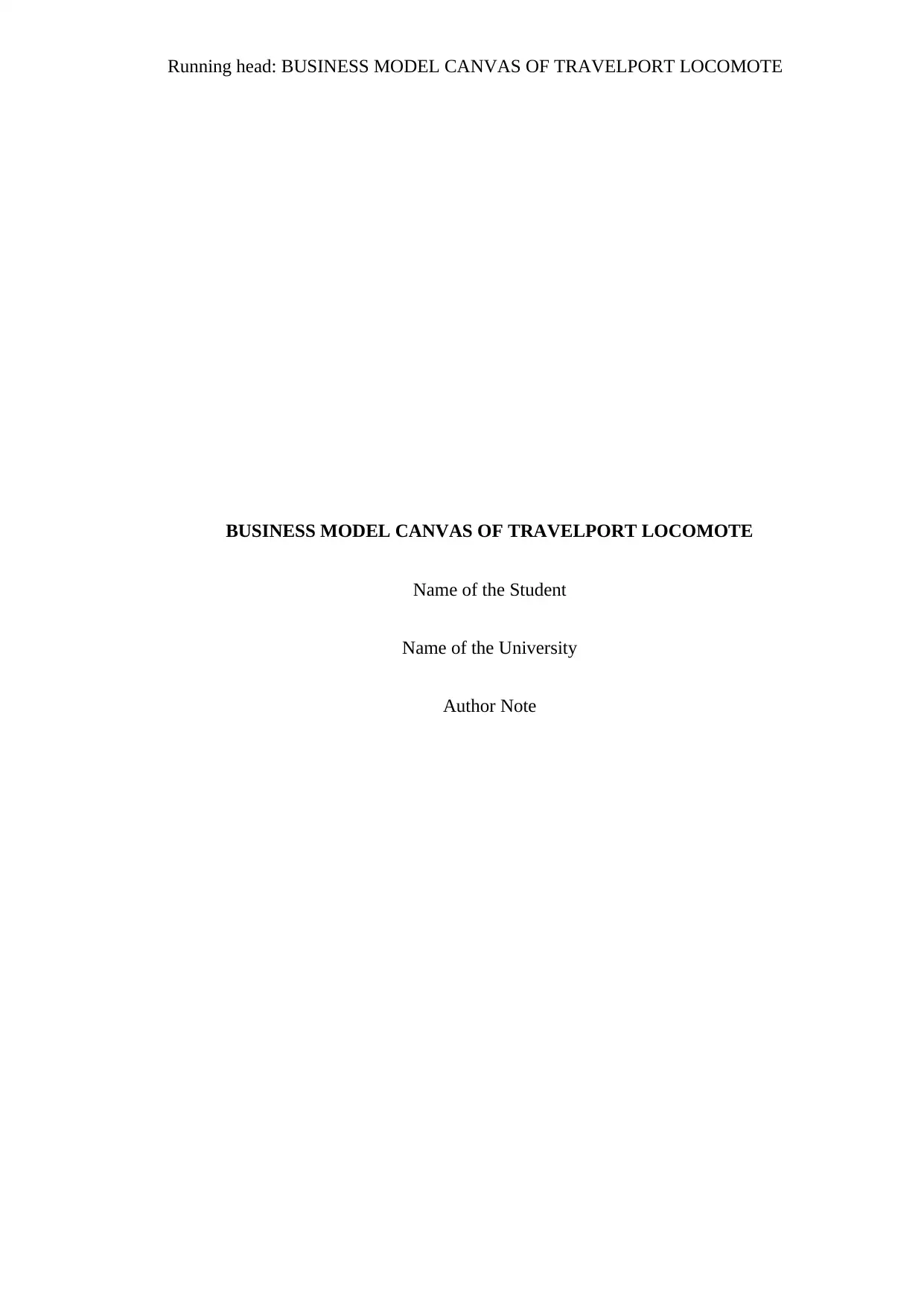
Running head: BUSINESS MODEL CANVAS OF TRAVELPORT LOCOMOTE
BUSINESS MODEL CANVAS OF TRAVELPORT LOCOMOTE
Name of the Student
Name of the University
Author Note
BUSINESS MODEL CANVAS OF TRAVELPORT LOCOMOTE
Name of the Student
Name of the University
Author Note
Paraphrase This Document
Need a fresh take? Get an instant paraphrase of this document with our AI Paraphraser
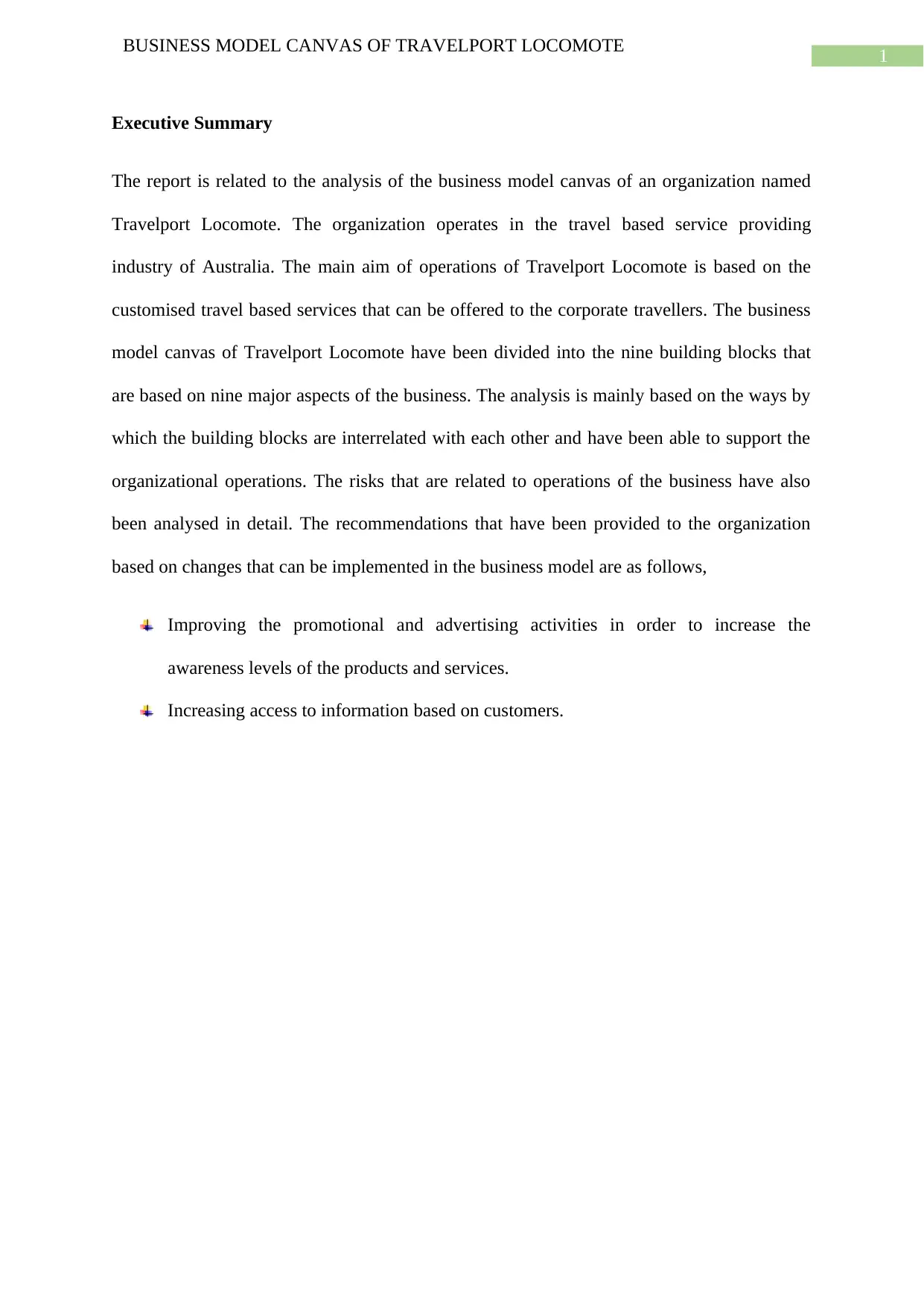
1
BUSINESS MODEL CANVAS OF TRAVELPORT LOCOMOTE
Executive Summary
The report is related to the analysis of the business model canvas of an organization named
Travelport Locomote. The organization operates in the travel based service providing
industry of Australia. The main aim of operations of Travelport Locomote is based on the
customised travel based services that can be offered to the corporate travellers. The business
model canvas of Travelport Locomote have been divided into the nine building blocks that
are based on nine major aspects of the business. The analysis is mainly based on the ways by
which the building blocks are interrelated with each other and have been able to support the
organizational operations. The risks that are related to operations of the business have also
been analysed in detail. The recommendations that have been provided to the organization
based on changes that can be implemented in the business model are as follows,
Improving the promotional and advertising activities in order to increase the
awareness levels of the products and services.
Increasing access to information based on customers.
BUSINESS MODEL CANVAS OF TRAVELPORT LOCOMOTE
Executive Summary
The report is related to the analysis of the business model canvas of an organization named
Travelport Locomote. The organization operates in the travel based service providing
industry of Australia. The main aim of operations of Travelport Locomote is based on the
customised travel based services that can be offered to the corporate travellers. The business
model canvas of Travelport Locomote have been divided into the nine building blocks that
are based on nine major aspects of the business. The analysis is mainly based on the ways by
which the building blocks are interrelated with each other and have been able to support the
organizational operations. The risks that are related to operations of the business have also
been analysed in detail. The recommendations that have been provided to the organization
based on changes that can be implemented in the business model are as follows,
Improving the promotional and advertising activities in order to increase the
awareness levels of the products and services.
Increasing access to information based on customers.
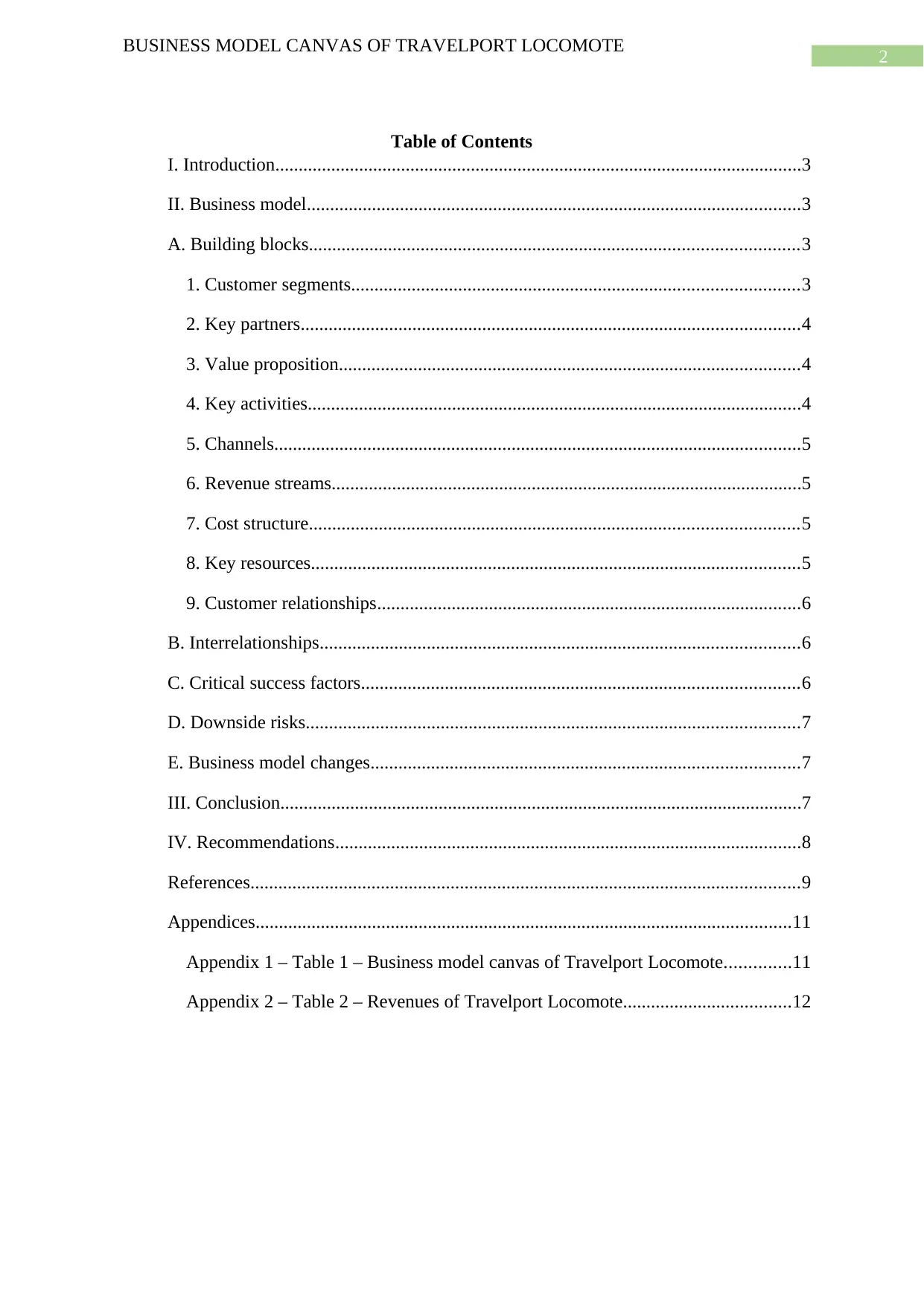
2
BUSINESS MODEL CANVAS OF TRAVELPORT LOCOMOTE
Table of Contents
I. Introduction.................................................................................................................3
II. Business model..........................................................................................................3
A. Building blocks.........................................................................................................3
1. Customer segments................................................................................................3
2. Key partners...........................................................................................................4
3. Value proposition...................................................................................................4
4. Key activities..........................................................................................................4
5. Channels.................................................................................................................5
6. Revenue streams.....................................................................................................5
7. Cost structure.........................................................................................................5
8. Key resources.........................................................................................................5
9. Customer relationships...........................................................................................6
B. Interrelationships.......................................................................................................6
C. Critical success factors..............................................................................................6
D. Downside risks..........................................................................................................7
E. Business model changes............................................................................................7
III. Conclusion................................................................................................................7
IV. Recommendations....................................................................................................8
References......................................................................................................................9
Appendices...................................................................................................................11
Appendix 1 – Table 1 – Business model canvas of Travelport Locomote..............11
Appendix 2 – Table 2 – Revenues of Travelport Locomote....................................12
BUSINESS MODEL CANVAS OF TRAVELPORT LOCOMOTE
Table of Contents
I. Introduction.................................................................................................................3
II. Business model..........................................................................................................3
A. Building blocks.........................................................................................................3
1. Customer segments................................................................................................3
2. Key partners...........................................................................................................4
3. Value proposition...................................................................................................4
4. Key activities..........................................................................................................4
5. Channels.................................................................................................................5
6. Revenue streams.....................................................................................................5
7. Cost structure.........................................................................................................5
8. Key resources.........................................................................................................5
9. Customer relationships...........................................................................................6
B. Interrelationships.......................................................................................................6
C. Critical success factors..............................................................................................6
D. Downside risks..........................................................................................................7
E. Business model changes............................................................................................7
III. Conclusion................................................................................................................7
IV. Recommendations....................................................................................................8
References......................................................................................................................9
Appendices...................................................................................................................11
Appendix 1 – Table 1 – Business model canvas of Travelport Locomote..............11
Appendix 2 – Table 2 – Revenues of Travelport Locomote....................................12
⊘ This is a preview!⊘
Do you want full access?
Subscribe today to unlock all pages.

Trusted by 1+ million students worldwide
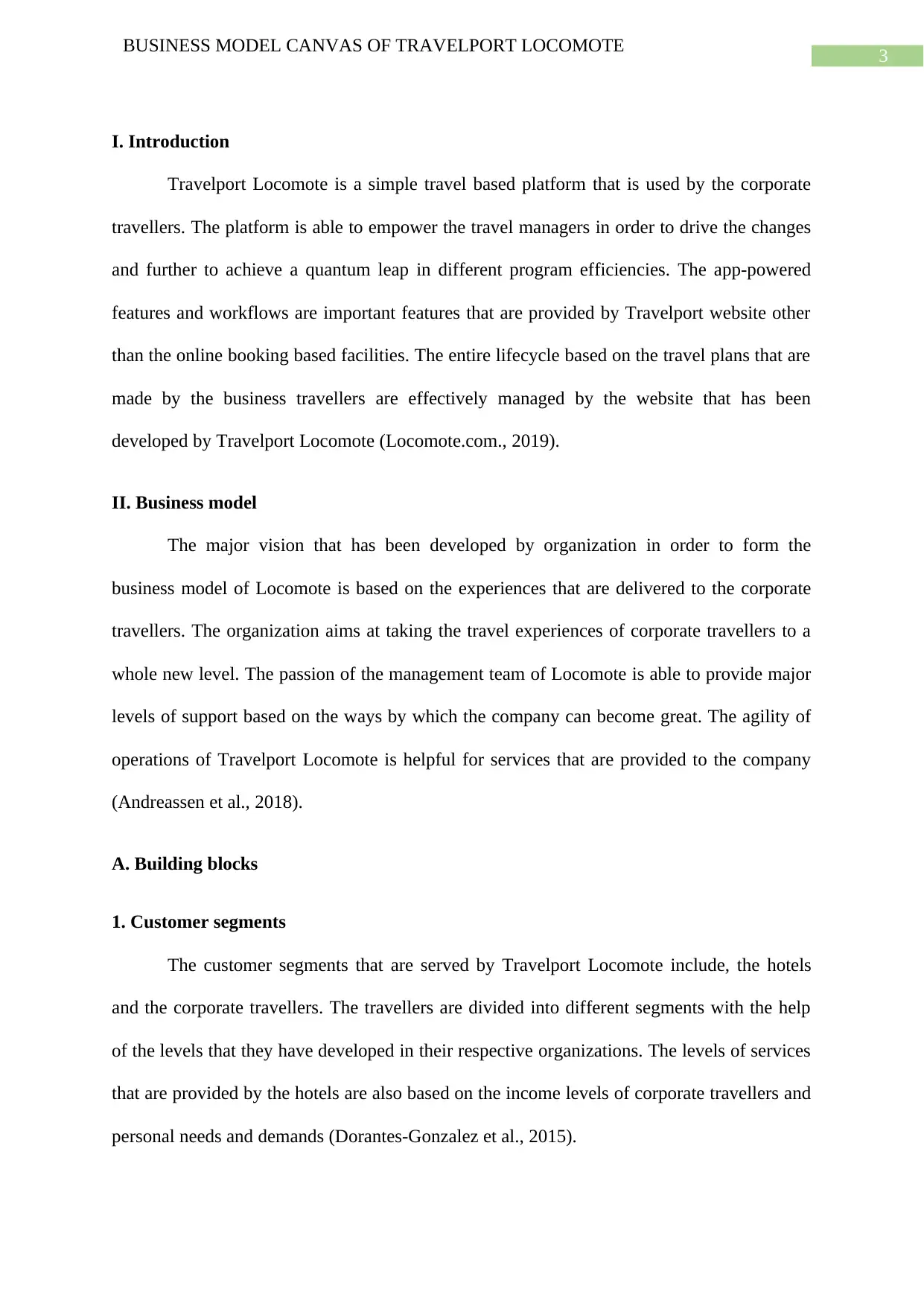
3
BUSINESS MODEL CANVAS OF TRAVELPORT LOCOMOTE
I. Introduction
Travelport Locomote is a simple travel based platform that is used by the corporate
travellers. The platform is able to empower the travel managers in order to drive the changes
and further to achieve a quantum leap in different program efficiencies. The app-powered
features and workflows are important features that are provided by Travelport website other
than the online booking based facilities. The entire lifecycle based on the travel plans that are
made by the business travellers are effectively managed by the website that has been
developed by Travelport Locomote (Locomote.com., 2019).
II. Business model
The major vision that has been developed by organization in order to form the
business model of Locomote is based on the experiences that are delivered to the corporate
travellers. The organization aims at taking the travel experiences of corporate travellers to a
whole new level. The passion of the management team of Locomote is able to provide major
levels of support based on the ways by which the company can become great. The agility of
operations of Travelport Locomote is helpful for services that are provided to the company
(Andreassen et al., 2018).
A. Building blocks
1. Customer segments
The customer segments that are served by Travelport Locomote include, the hotels
and the corporate travellers. The travellers are divided into different segments with the help
of the levels that they have developed in their respective organizations. The levels of services
that are provided by the hotels are also based on the income levels of corporate travellers and
personal needs and demands (Dorantes-Gonzalez et al., 2015).
BUSINESS MODEL CANVAS OF TRAVELPORT LOCOMOTE
I. Introduction
Travelport Locomote is a simple travel based platform that is used by the corporate
travellers. The platform is able to empower the travel managers in order to drive the changes
and further to achieve a quantum leap in different program efficiencies. The app-powered
features and workflows are important features that are provided by Travelport website other
than the online booking based facilities. The entire lifecycle based on the travel plans that are
made by the business travellers are effectively managed by the website that has been
developed by Travelport Locomote (Locomote.com., 2019).
II. Business model
The major vision that has been developed by organization in order to form the
business model of Locomote is based on the experiences that are delivered to the corporate
travellers. The organization aims at taking the travel experiences of corporate travellers to a
whole new level. The passion of the management team of Locomote is able to provide major
levels of support based on the ways by which the company can become great. The agility of
operations of Travelport Locomote is helpful for services that are provided to the company
(Andreassen et al., 2018).
A. Building blocks
1. Customer segments
The customer segments that are served by Travelport Locomote include, the hotels
and the corporate travellers. The travellers are divided into different segments with the help
of the levels that they have developed in their respective organizations. The levels of services
that are provided by the hotels are also based on the income levels of corporate travellers and
personal needs and demands (Dorantes-Gonzalez et al., 2015).
Paraphrase This Document
Need a fresh take? Get an instant paraphrase of this document with our AI Paraphraser
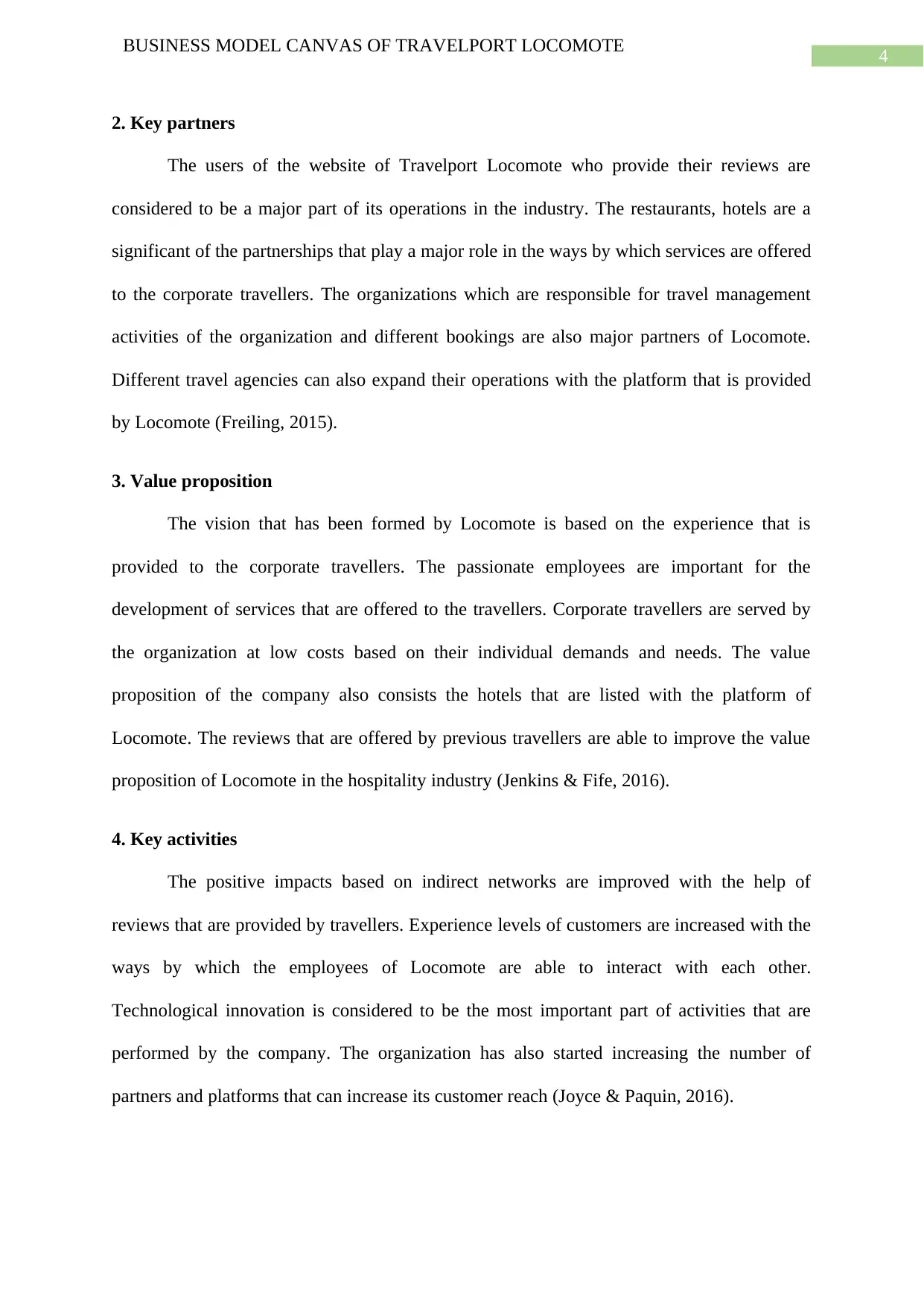
4
BUSINESS MODEL CANVAS OF TRAVELPORT LOCOMOTE
2. Key partners
The users of the website of Travelport Locomote who provide their reviews are
considered to be a major part of its operations in the industry. The restaurants, hotels are a
significant of the partnerships that play a major role in the ways by which services are offered
to the corporate travellers. The organizations which are responsible for travel management
activities of the organization and different bookings are also major partners of Locomote.
Different travel agencies can also expand their operations with the platform that is provided
by Locomote (Freiling, 2015).
3. Value proposition
The vision that has been formed by Locomote is based on the experience that is
provided to the corporate travellers. The passionate employees are important for the
development of services that are offered to the travellers. Corporate travellers are served by
the organization at low costs based on their individual demands and needs. The value
proposition of the company also consists the hotels that are listed with the platform of
Locomote. The reviews that are offered by previous travellers are able to improve the value
proposition of Locomote in the hospitality industry (Jenkins & Fife, 2016).
4. Key activities
The positive impacts based on indirect networks are improved with the help of
reviews that are provided by travellers. Experience levels of customers are increased with the
ways by which the employees of Locomote are able to interact with each other.
Technological innovation is considered to be the most important part of activities that are
performed by the company. The organization has also started increasing the number of
partners and platforms that can increase its customer reach (Joyce & Paquin, 2016).
BUSINESS MODEL CANVAS OF TRAVELPORT LOCOMOTE
2. Key partners
The users of the website of Travelport Locomote who provide their reviews are
considered to be a major part of its operations in the industry. The restaurants, hotels are a
significant of the partnerships that play a major role in the ways by which services are offered
to the corporate travellers. The organizations which are responsible for travel management
activities of the organization and different bookings are also major partners of Locomote.
Different travel agencies can also expand their operations with the platform that is provided
by Locomote (Freiling, 2015).
3. Value proposition
The vision that has been formed by Locomote is based on the experience that is
provided to the corporate travellers. The passionate employees are important for the
development of services that are offered to the travellers. Corporate travellers are served by
the organization at low costs based on their individual demands and needs. The value
proposition of the company also consists the hotels that are listed with the platform of
Locomote. The reviews that are offered by previous travellers are able to improve the value
proposition of Locomote in the hospitality industry (Jenkins & Fife, 2016).
4. Key activities
The positive impacts based on indirect networks are improved with the help of
reviews that are provided by travellers. Experience levels of customers are increased with the
ways by which the employees of Locomote are able to interact with each other.
Technological innovation is considered to be the most important part of activities that are
performed by the company. The organization has also started increasing the number of
partners and platforms that can increase its customer reach (Joyce & Paquin, 2016).
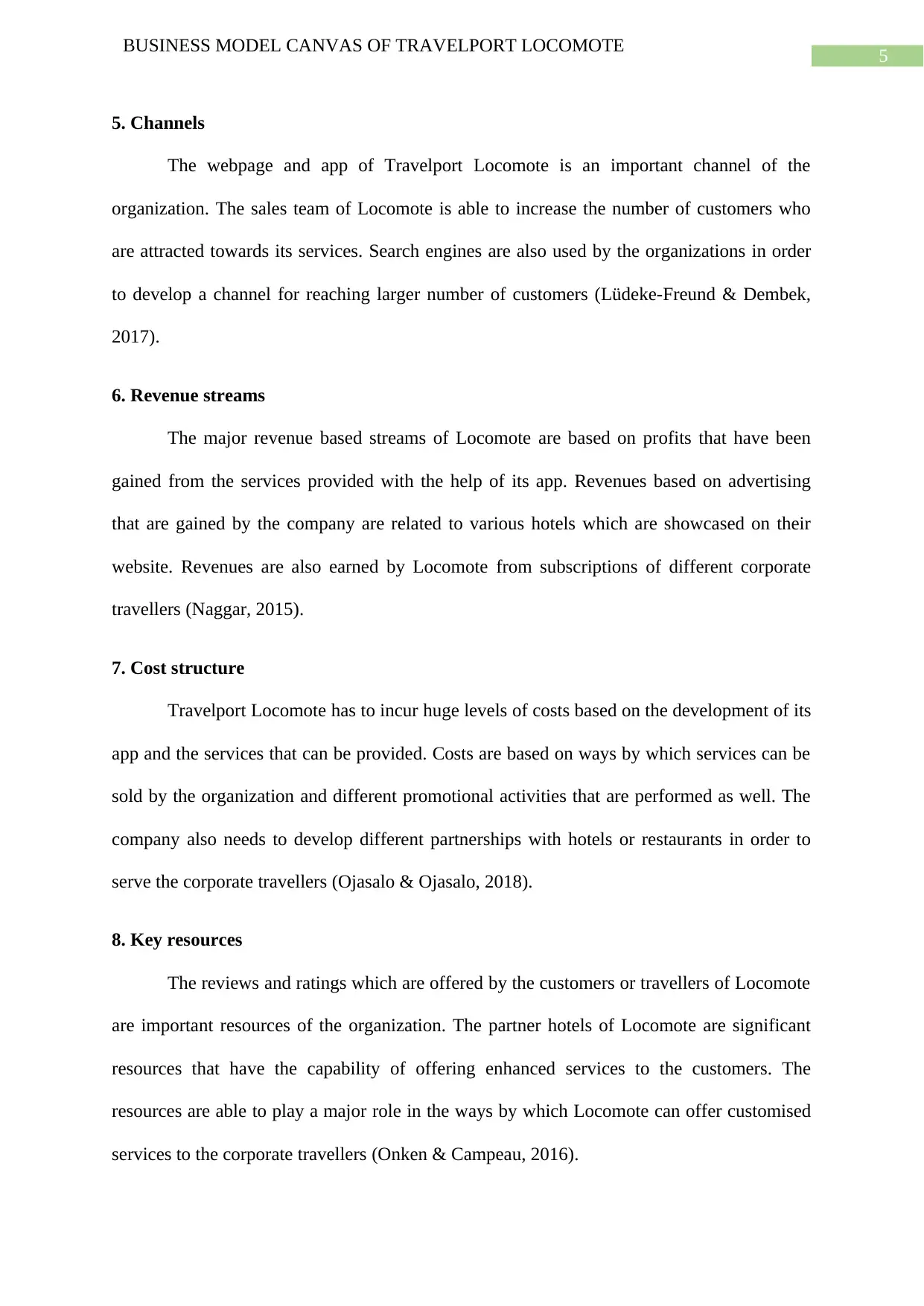
5
BUSINESS MODEL CANVAS OF TRAVELPORT LOCOMOTE
5. Channels
The webpage and app of Travelport Locomote is an important channel of the
organization. The sales team of Locomote is able to increase the number of customers who
are attracted towards its services. Search engines are also used by the organizations in order
to develop a channel for reaching larger number of customers (Lüdeke-Freund & Dembek,
2017).
6. Revenue streams
The major revenue based streams of Locomote are based on profits that have been
gained from the services provided with the help of its app. Revenues based on advertising
that are gained by the company are related to various hotels which are showcased on their
website. Revenues are also earned by Locomote from subscriptions of different corporate
travellers (Naggar, 2015).
7. Cost structure
Travelport Locomote has to incur huge levels of costs based on the development of its
app and the services that can be provided. Costs are based on ways by which services can be
sold by the organization and different promotional activities that are performed as well. The
company also needs to develop different partnerships with hotels or restaurants in order to
serve the corporate travellers (Ojasalo & Ojasalo, 2018).
8. Key resources
The reviews and ratings which are offered by the customers or travellers of Locomote
are important resources of the organization. The partner hotels of Locomote are significant
resources that have the capability of offering enhanced services to the customers. The
resources are able to play a major role in the ways by which Locomote can offer customised
services to the corporate travellers (Onken & Campeau, 2016).
BUSINESS MODEL CANVAS OF TRAVELPORT LOCOMOTE
5. Channels
The webpage and app of Travelport Locomote is an important channel of the
organization. The sales team of Locomote is able to increase the number of customers who
are attracted towards its services. Search engines are also used by the organizations in order
to develop a channel for reaching larger number of customers (Lüdeke-Freund & Dembek,
2017).
6. Revenue streams
The major revenue based streams of Locomote are based on profits that have been
gained from the services provided with the help of its app. Revenues based on advertising
that are gained by the company are related to various hotels which are showcased on their
website. Revenues are also earned by Locomote from subscriptions of different corporate
travellers (Naggar, 2015).
7. Cost structure
Travelport Locomote has to incur huge levels of costs based on the development of its
app and the services that can be provided. Costs are based on ways by which services can be
sold by the organization and different promotional activities that are performed as well. The
company also needs to develop different partnerships with hotels or restaurants in order to
serve the corporate travellers (Ojasalo & Ojasalo, 2018).
8. Key resources
The reviews and ratings which are offered by the customers or travellers of Locomote
are important resources of the organization. The partner hotels of Locomote are significant
resources that have the capability of offering enhanced services to the customers. The
resources are able to play a major role in the ways by which Locomote can offer customised
services to the corporate travellers (Onken & Campeau, 2016).
⊘ This is a preview!⊘
Do you want full access?
Subscribe today to unlock all pages.

Trusted by 1+ million students worldwide
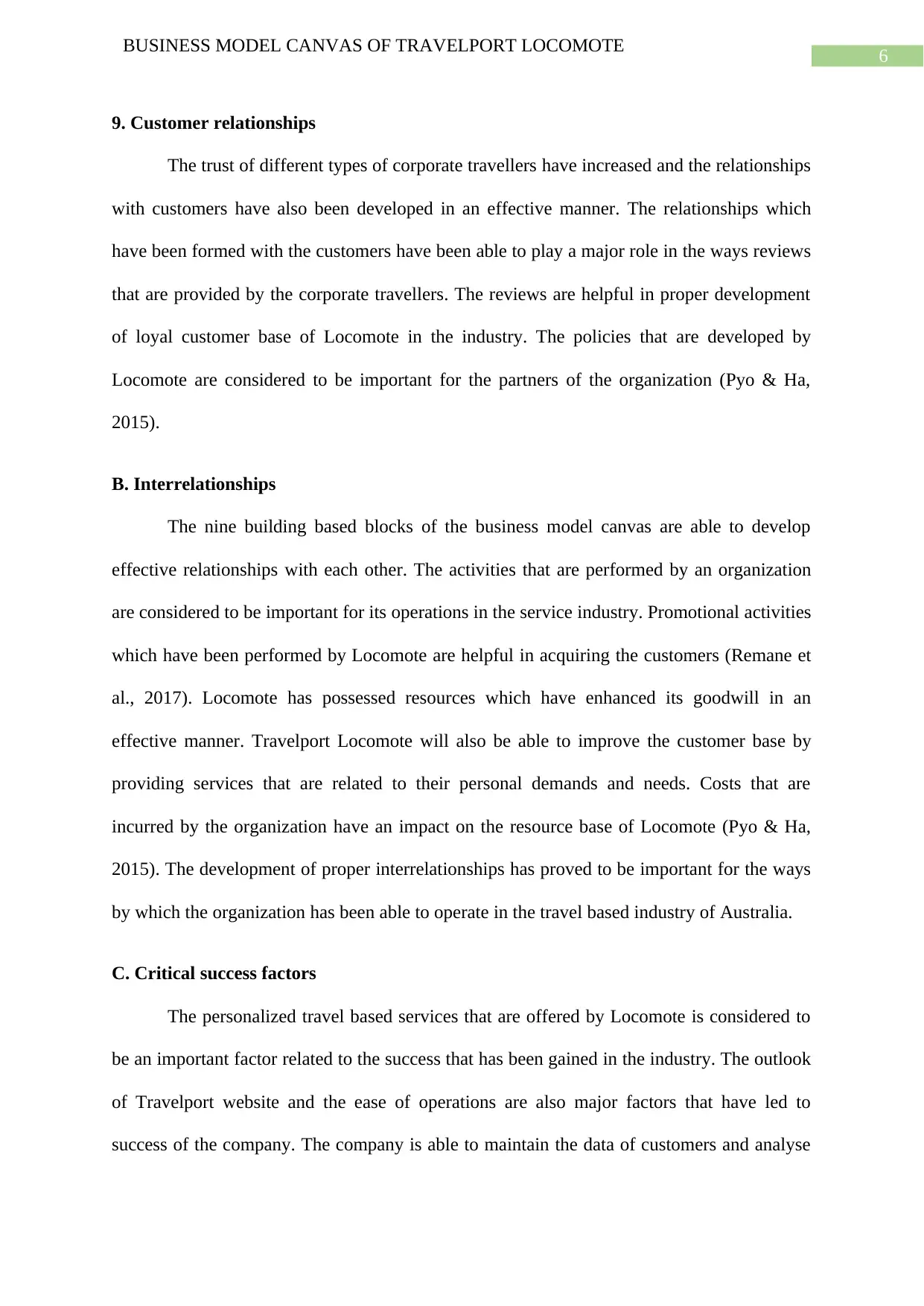
6
BUSINESS MODEL CANVAS OF TRAVELPORT LOCOMOTE
9. Customer relationships
The trust of different types of corporate travellers have increased and the relationships
with customers have also been developed in an effective manner. The relationships which
have been formed with the customers have been able to play a major role in the ways reviews
that are provided by the corporate travellers. The reviews are helpful in proper development
of loyal customer base of Locomote in the industry. The policies that are developed by
Locomote are considered to be important for the partners of the organization (Pyo & Ha,
2015).
B. Interrelationships
The nine building based blocks of the business model canvas are able to develop
effective relationships with each other. The activities that are performed by an organization
are considered to be important for its operations in the service industry. Promotional activities
which have been performed by Locomote are helpful in acquiring the customers (Remane et
al., 2017). Locomote has possessed resources which have enhanced its goodwill in an
effective manner. Travelport Locomote will also be able to improve the customer base by
providing services that are related to their personal demands and needs. Costs that are
incurred by the organization have an impact on the resource base of Locomote (Pyo & Ha,
2015). The development of proper interrelationships has proved to be important for the ways
by which the organization has been able to operate in the travel based industry of Australia.
C. Critical success factors
The personalized travel based services that are offered by Locomote is considered to
be an important factor related to the success that has been gained in the industry. The outlook
of Travelport website and the ease of operations are also major factors that have led to
success of the company. The company is able to maintain the data of customers and analyse
BUSINESS MODEL CANVAS OF TRAVELPORT LOCOMOTE
9. Customer relationships
The trust of different types of corporate travellers have increased and the relationships
with customers have also been developed in an effective manner. The relationships which
have been formed with the customers have been able to play a major role in the ways reviews
that are provided by the corporate travellers. The reviews are helpful in proper development
of loyal customer base of Locomote in the industry. The policies that are developed by
Locomote are considered to be important for the partners of the organization (Pyo & Ha,
2015).
B. Interrelationships
The nine building based blocks of the business model canvas are able to develop
effective relationships with each other. The activities that are performed by an organization
are considered to be important for its operations in the service industry. Promotional activities
which have been performed by Locomote are helpful in acquiring the customers (Remane et
al., 2017). Locomote has possessed resources which have enhanced its goodwill in an
effective manner. Travelport Locomote will also be able to improve the customer base by
providing services that are related to their personal demands and needs. Costs that are
incurred by the organization have an impact on the resource base of Locomote (Pyo & Ha,
2015). The development of proper interrelationships has proved to be important for the ways
by which the organization has been able to operate in the travel based industry of Australia.
C. Critical success factors
The personalized travel based services that are offered by Locomote is considered to
be an important factor related to the success that has been gained in the industry. The outlook
of Travelport website and the ease of operations are also major factors that have led to
success of the company. The company is able to maintain the data of customers and analyse
Paraphrase This Document
Need a fresh take? Get an instant paraphrase of this document with our AI Paraphraser
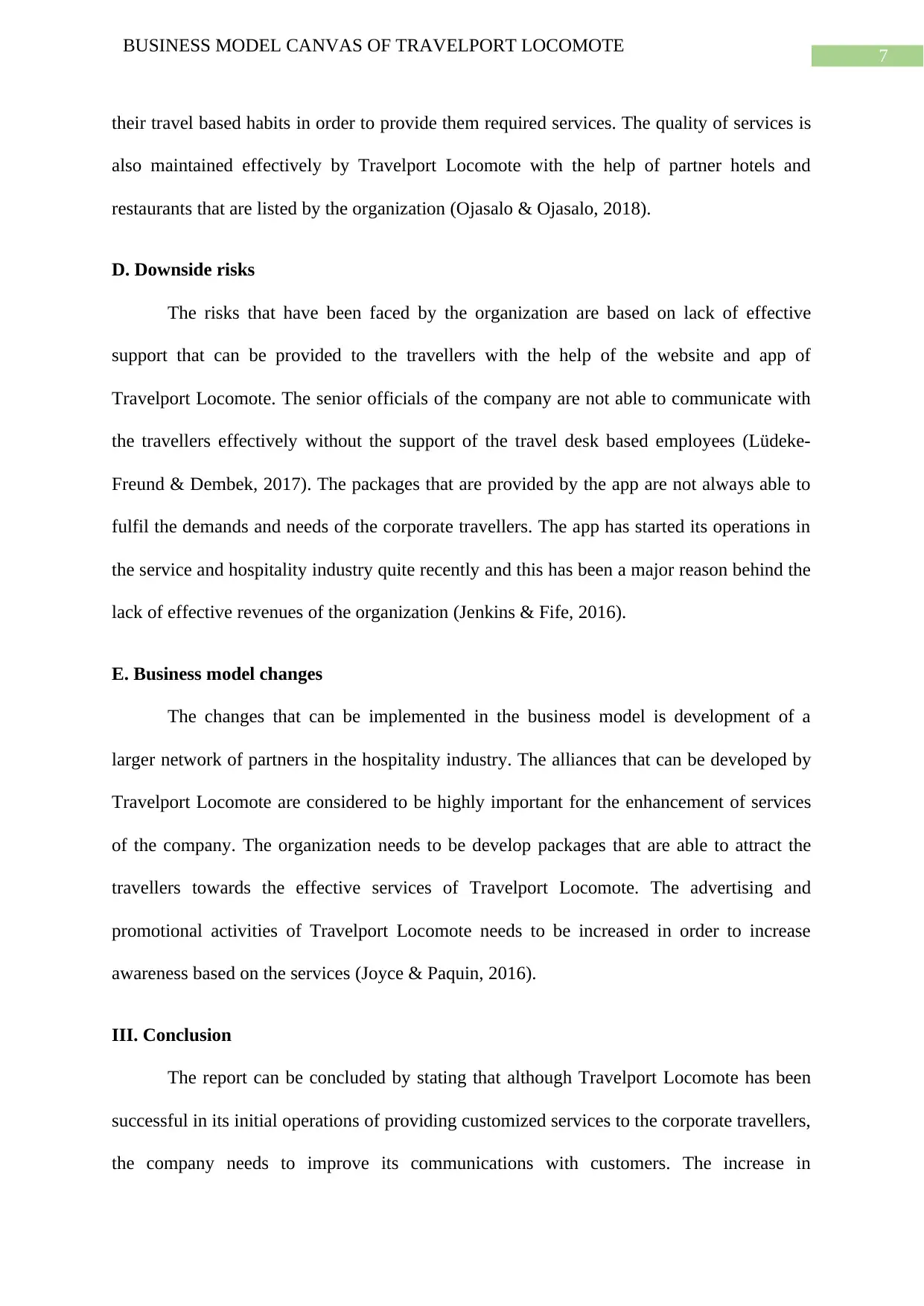
7
BUSINESS MODEL CANVAS OF TRAVELPORT LOCOMOTE
their travel based habits in order to provide them required services. The quality of services is
also maintained effectively by Travelport Locomote with the help of partner hotels and
restaurants that are listed by the organization (Ojasalo & Ojasalo, 2018).
D. Downside risks
The risks that have been faced by the organization are based on lack of effective
support that can be provided to the travellers with the help of the website and app of
Travelport Locomote. The senior officials of the company are not able to communicate with
the travellers effectively without the support of the travel desk based employees (Lüdeke-
Freund & Dembek, 2017). The packages that are provided by the app are not always able to
fulfil the demands and needs of the corporate travellers. The app has started its operations in
the service and hospitality industry quite recently and this has been a major reason behind the
lack of effective revenues of the organization (Jenkins & Fife, 2016).
E. Business model changes
The changes that can be implemented in the business model is development of a
larger network of partners in the hospitality industry. The alliances that can be developed by
Travelport Locomote are considered to be highly important for the enhancement of services
of the company. The organization needs to be develop packages that are able to attract the
travellers towards the effective services of Travelport Locomote. The advertising and
promotional activities of Travelport Locomote needs to be increased in order to increase
awareness based on the services (Joyce & Paquin, 2016).
III. Conclusion
The report can be concluded by stating that although Travelport Locomote has been
successful in its initial operations of providing customized services to the corporate travellers,
the company needs to improve its communications with customers. The increase in
BUSINESS MODEL CANVAS OF TRAVELPORT LOCOMOTE
their travel based habits in order to provide them required services. The quality of services is
also maintained effectively by Travelport Locomote with the help of partner hotels and
restaurants that are listed by the organization (Ojasalo & Ojasalo, 2018).
D. Downside risks
The risks that have been faced by the organization are based on lack of effective
support that can be provided to the travellers with the help of the website and app of
Travelport Locomote. The senior officials of the company are not able to communicate with
the travellers effectively without the support of the travel desk based employees (Lüdeke-
Freund & Dembek, 2017). The packages that are provided by the app are not always able to
fulfil the demands and needs of the corporate travellers. The app has started its operations in
the service and hospitality industry quite recently and this has been a major reason behind the
lack of effective revenues of the organization (Jenkins & Fife, 2016).
E. Business model changes
The changes that can be implemented in the business model is development of a
larger network of partners in the hospitality industry. The alliances that can be developed by
Travelport Locomote are considered to be highly important for the enhancement of services
of the company. The organization needs to be develop packages that are able to attract the
travellers towards the effective services of Travelport Locomote. The advertising and
promotional activities of Travelport Locomote needs to be increased in order to increase
awareness based on the services (Joyce & Paquin, 2016).
III. Conclusion
The report can be concluded by stating that although Travelport Locomote has been
successful in its initial operations of providing customized services to the corporate travellers,
the company needs to improve its communications with customers. The increase in
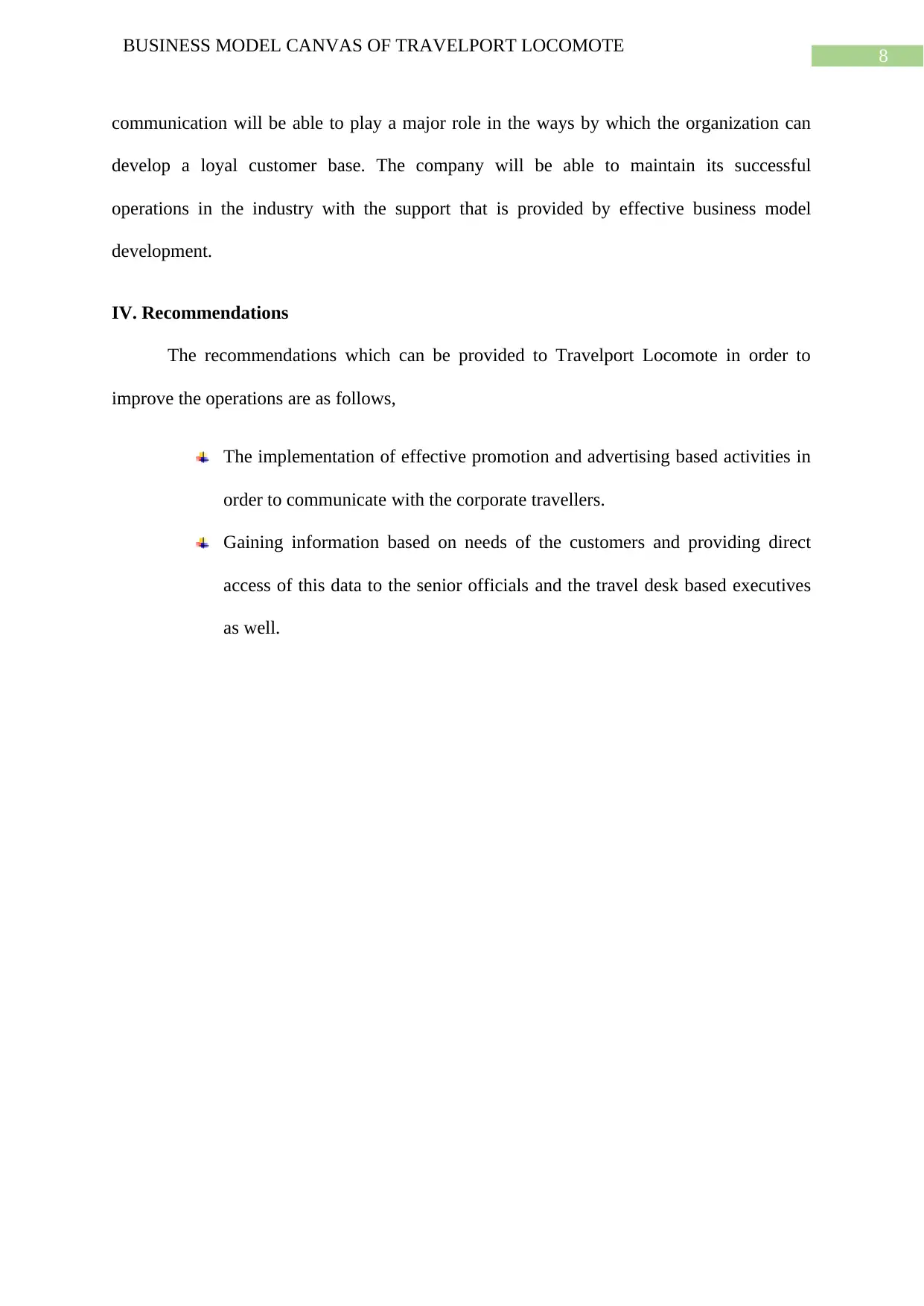
8
BUSINESS MODEL CANVAS OF TRAVELPORT LOCOMOTE
communication will be able to play a major role in the ways by which the organization can
develop a loyal customer base. The company will be able to maintain its successful
operations in the industry with the support that is provided by effective business model
development.
IV. Recommendations
The recommendations which can be provided to Travelport Locomote in order to
improve the operations are as follows,
The implementation of effective promotion and advertising based activities in
order to communicate with the corporate travellers.
Gaining information based on needs of the customers and providing direct
access of this data to the senior officials and the travel desk based executives
as well.
BUSINESS MODEL CANVAS OF TRAVELPORT LOCOMOTE
communication will be able to play a major role in the ways by which the organization can
develop a loyal customer base. The company will be able to maintain its successful
operations in the industry with the support that is provided by effective business model
development.
IV. Recommendations
The recommendations which can be provided to Travelport Locomote in order to
improve the operations are as follows,
The implementation of effective promotion and advertising based activities in
order to communicate with the corporate travellers.
Gaining information based on needs of the customers and providing direct
access of this data to the senior officials and the travel desk based executives
as well.
⊘ This is a preview!⊘
Do you want full access?
Subscribe today to unlock all pages.

Trusted by 1+ million students worldwide
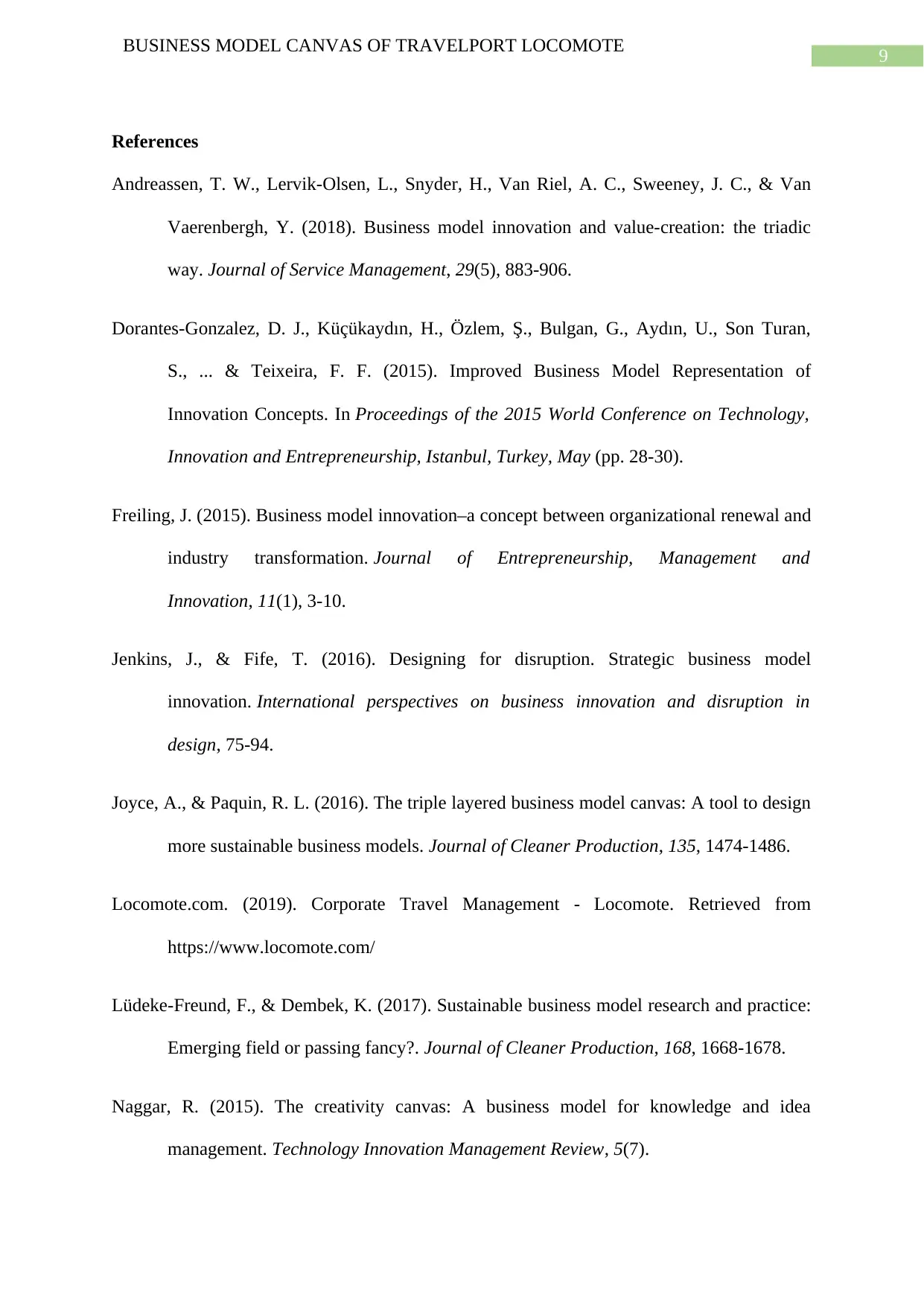
9
BUSINESS MODEL CANVAS OF TRAVELPORT LOCOMOTE
References
Andreassen, T. W., Lervik-Olsen, L., Snyder, H., Van Riel, A. C., Sweeney, J. C., & Van
Vaerenbergh, Y. (2018). Business model innovation and value-creation: the triadic
way. Journal of Service Management, 29(5), 883-906.
Dorantes-Gonzalez, D. J., Küçükaydın, H., Özlem, Ş., Bulgan, G., Aydın, U., Son Turan,
S., ... & Teixeira, F. F. (2015). Improved Business Model Representation of
Innovation Concepts. In Proceedings of the 2015 World Conference on Technology,
Innovation and Entrepreneurship, Istanbul, Turkey, May (pp. 28-30).
Freiling, J. (2015). Business model innovation–a concept between organizational renewal and
industry transformation. Journal of Entrepreneurship, Management and
Innovation, 11(1), 3-10.
Jenkins, J., & Fife, T. (2016). Designing for disruption. Strategic business model
innovation. International perspectives on business innovation and disruption in
design, 75-94.
Joyce, A., & Paquin, R. L. (2016). The triple layered business model canvas: A tool to design
more sustainable business models. Journal of Cleaner Production, 135, 1474-1486.
Locomote.com. (2019). Corporate Travel Management - Locomote. Retrieved from
https://www.locomote.com/
Lüdeke-Freund, F., & Dembek, K. (2017). Sustainable business model research and practice:
Emerging field or passing fancy?. Journal of Cleaner Production, 168, 1668-1678.
Naggar, R. (2015). The creativity canvas: A business model for knowledge and idea
management. Technology Innovation Management Review, 5(7).
BUSINESS MODEL CANVAS OF TRAVELPORT LOCOMOTE
References
Andreassen, T. W., Lervik-Olsen, L., Snyder, H., Van Riel, A. C., Sweeney, J. C., & Van
Vaerenbergh, Y. (2018). Business model innovation and value-creation: the triadic
way. Journal of Service Management, 29(5), 883-906.
Dorantes-Gonzalez, D. J., Küçükaydın, H., Özlem, Ş., Bulgan, G., Aydın, U., Son Turan,
S., ... & Teixeira, F. F. (2015). Improved Business Model Representation of
Innovation Concepts. In Proceedings of the 2015 World Conference on Technology,
Innovation and Entrepreneurship, Istanbul, Turkey, May (pp. 28-30).
Freiling, J. (2015). Business model innovation–a concept between organizational renewal and
industry transformation. Journal of Entrepreneurship, Management and
Innovation, 11(1), 3-10.
Jenkins, J., & Fife, T. (2016). Designing for disruption. Strategic business model
innovation. International perspectives on business innovation and disruption in
design, 75-94.
Joyce, A., & Paquin, R. L. (2016). The triple layered business model canvas: A tool to design
more sustainable business models. Journal of Cleaner Production, 135, 1474-1486.
Locomote.com. (2019). Corporate Travel Management - Locomote. Retrieved from
https://www.locomote.com/
Lüdeke-Freund, F., & Dembek, K. (2017). Sustainable business model research and practice:
Emerging field or passing fancy?. Journal of Cleaner Production, 168, 1668-1678.
Naggar, R. (2015). The creativity canvas: A business model for knowledge and idea
management. Technology Innovation Management Review, 5(7).
Paraphrase This Document
Need a fresh take? Get an instant paraphrase of this document with our AI Paraphraser
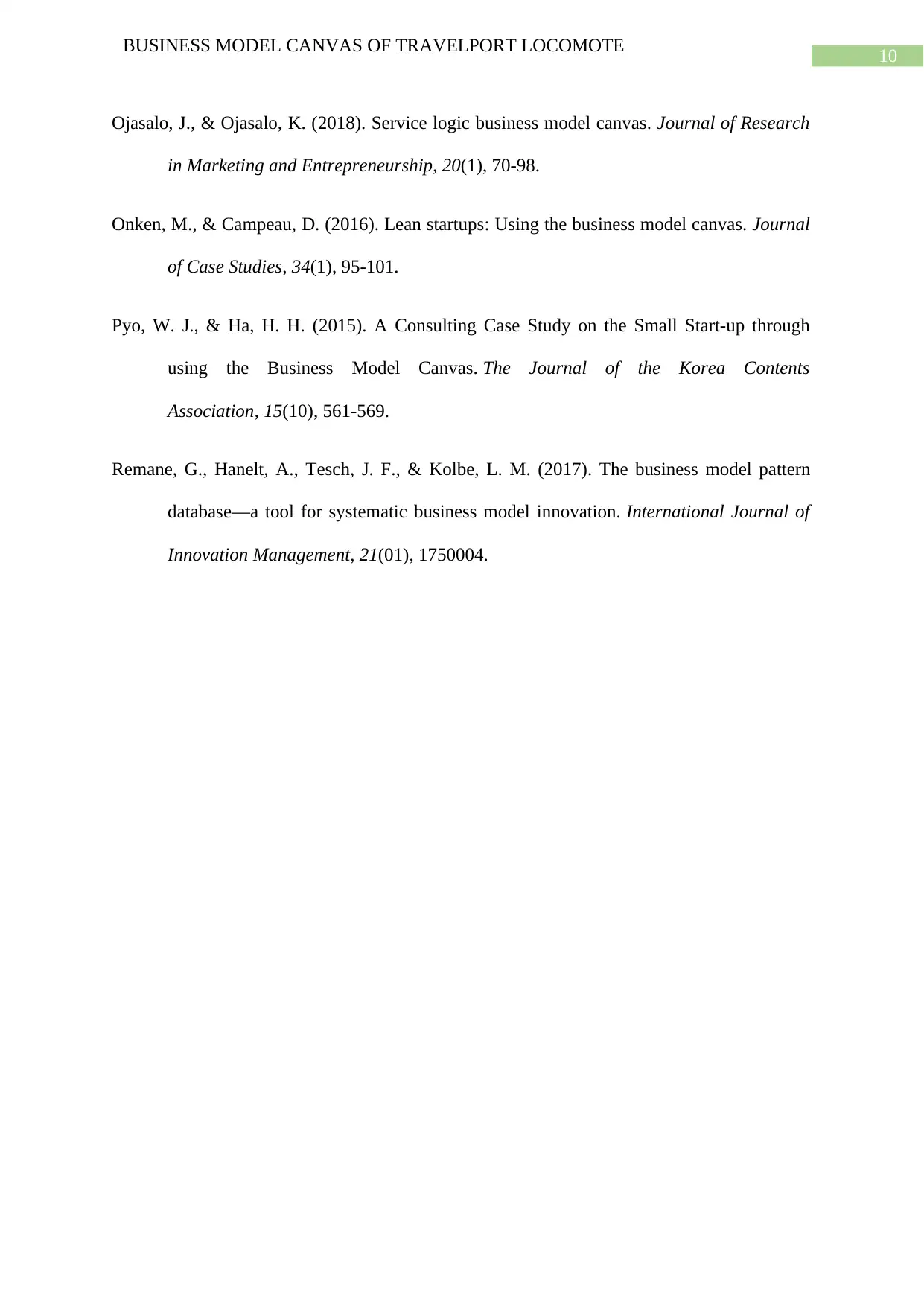
10
BUSINESS MODEL CANVAS OF TRAVELPORT LOCOMOTE
Ojasalo, J., & Ojasalo, K. (2018). Service logic business model canvas. Journal of Research
in Marketing and Entrepreneurship, 20(1), 70-98.
Onken, M., & Campeau, D. (2016). Lean startups: Using the business model canvas. Journal
of Case Studies, 34(1), 95-101.
Pyo, W. J., & Ha, H. H. (2015). A Consulting Case Study on the Small Start-up through
using the Business Model Canvas. The Journal of the Korea Contents
Association, 15(10), 561-569.
Remane, G., Hanelt, A., Tesch, J. F., & Kolbe, L. M. (2017). The business model pattern
database—a tool for systematic business model innovation. International Journal of
Innovation Management, 21(01), 1750004.
BUSINESS MODEL CANVAS OF TRAVELPORT LOCOMOTE
Ojasalo, J., & Ojasalo, K. (2018). Service logic business model canvas. Journal of Research
in Marketing and Entrepreneurship, 20(1), 70-98.
Onken, M., & Campeau, D. (2016). Lean startups: Using the business model canvas. Journal
of Case Studies, 34(1), 95-101.
Pyo, W. J., & Ha, H. H. (2015). A Consulting Case Study on the Small Start-up through
using the Business Model Canvas. The Journal of the Korea Contents
Association, 15(10), 561-569.
Remane, G., Hanelt, A., Tesch, J. F., & Kolbe, L. M. (2017). The business model pattern
database—a tool for systematic business model innovation. International Journal of
Innovation Management, 21(01), 1750004.
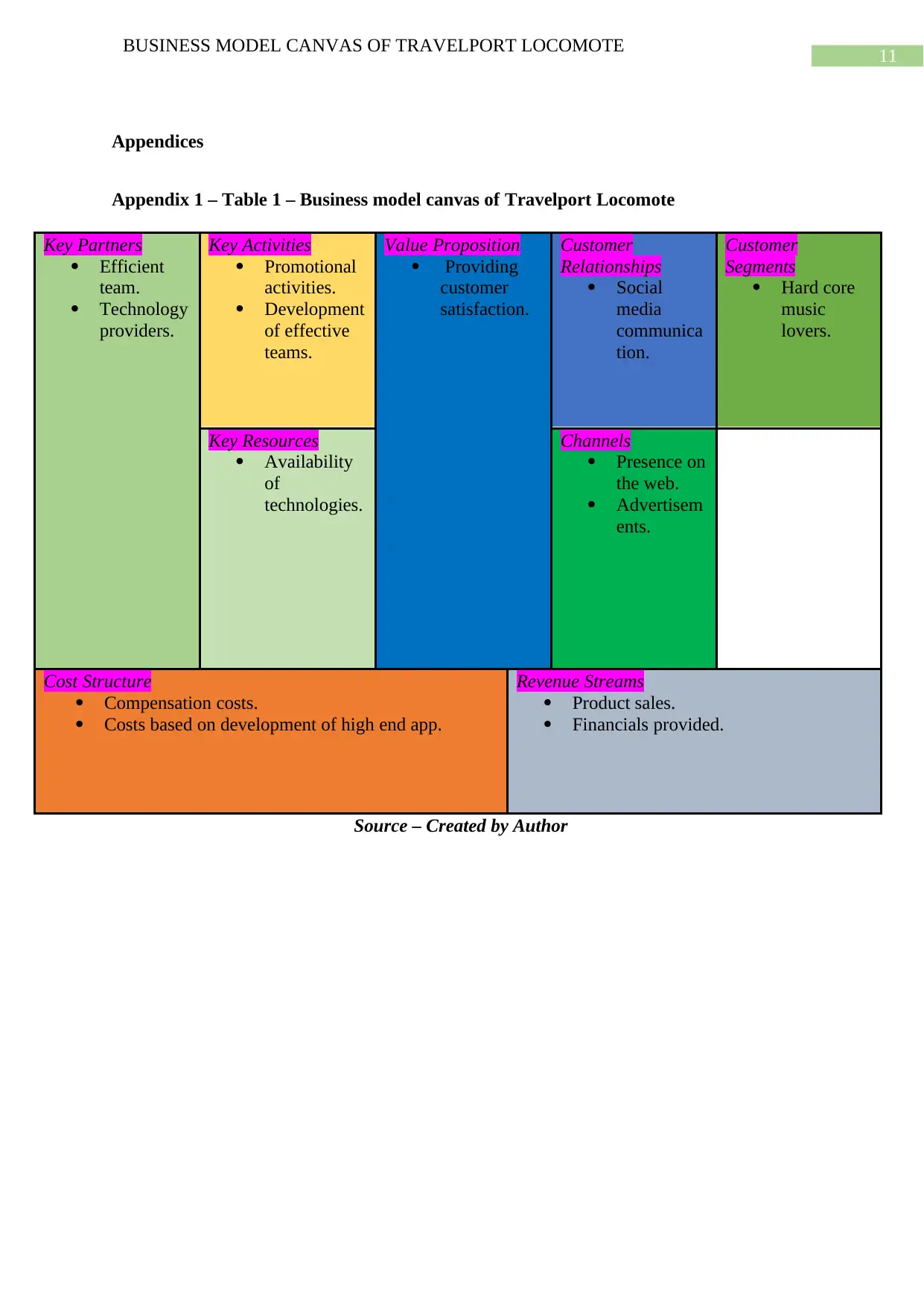
11
BUSINESS MODEL CANVAS OF TRAVELPORT LOCOMOTE
Appendices
Appendix 1 – Table 1 – Business model canvas of Travelport Locomote
Key Partners
Efficient
team.
Technology
providers.
Key Activities
Promotional
activities.
Development
of effective
teams.
Value Proposition
Providing
customer
satisfaction.
Customer
Relationships
Social
media
communica
tion.
Customer
Segments
Hard core
music
lovers.
Key Resources
Availability
of
technologies.
Channels
Presence on
the web.
Advertisem
ents.
Cost Structure
Compensation costs.
Costs based on development of high end app.
Revenue Streams
Product sales.
Financials provided.
Source – Created by Author
BUSINESS MODEL CANVAS OF TRAVELPORT LOCOMOTE
Appendices
Appendix 1 – Table 1 – Business model canvas of Travelport Locomote
Key Partners
Efficient
team.
Technology
providers.
Key Activities
Promotional
activities.
Development
of effective
teams.
Value Proposition
Providing
customer
satisfaction.
Customer
Relationships
Social
media
communica
tion.
Customer
Segments
Hard core
music
lovers.
Key Resources
Availability
of
technologies.
Channels
Presence on
the web.
Advertisem
ents.
Cost Structure
Compensation costs.
Costs based on development of high end app.
Revenue Streams
Product sales.
Financials provided.
Source – Created by Author
⊘ This is a preview!⊘
Do you want full access?
Subscribe today to unlock all pages.

Trusted by 1+ million students worldwide
1 out of 13
Related Documents
Your All-in-One AI-Powered Toolkit for Academic Success.
+13062052269
info@desklib.com
Available 24*7 on WhatsApp / Email
![[object Object]](/_next/static/media/star-bottom.7253800d.svg)
Unlock your academic potential
Copyright © 2020–2025 A2Z Services. All Rights Reserved. Developed and managed by ZUCOL.





